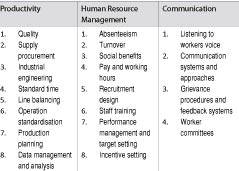Dr. Rajesh Bheda of Rajesh Bheda Consulting and its strategic partner Rosey Hurst from Impactt Limited, UK have been advocating and adopting a collaborative approach that helps international brands/retailers and apparel manufacturers to work together to implement an improvement strategy that enables companies to improve performance as well as working conditions in their supply chain in a way that brings clear business benefits to both ends of the chain including the workers. The companies whose case studies have been published below have requested for anonymity, however, Editor-in-Chief SW has the names and in case of reference readers may contact him for details.
The results of the Improvement strategy initiated through the RAGS Fund Project have been very exciting on productivity, quality and HR fronts. In the first six months of implementation of the project, the participating factories were able to achieve noteworthy results.
• Productivity increase on an average was 25% with highest of 77%,
• Cut to ship ratio has improved on an average by 2.69% resulting in projected annual gains of about 2.16 million USD per factory,
• Absenteeism has reduced by 21% in India and 57% in Bangladesh,
• Labour turnover has reduced by 25% from baseline level of 12% in the Indian participating factories,
• Most of the participating factories have introduced attendance bonus and are in the process of introducing the production bonus scheme to reward the workers for the increased productivity.
The first year of the project aimed at boosting competitiveness through in-factory training and consulting support in the areas of Productivity-Quality, HRM and Communication as detailed in Table 1.

The results from 3 companies where the project was undertaken underline the individual results that the companies could achieve through the program… It is important to understand that the significant improvements in critical performance indicators were achieved through the engagement of all concerned. The HR and Communications training helped create conducive environment for managing production with greater worker stability and reduced absenteeism. Workers management communication channels improved and resulted in enhanced trust. Productivity and quality improvement brought substantial economic savings that could be used for rewarding the stakeholders and sustaining the improvement processes.
Case One – Tirupur based Garment Factory
A factory based in Tirupur set its main objectives as reducing absenteeism and increasing efficiency. Six months into the programme, the HR team had increased its interactions with workers, explaining the policies and procedures, offering more support and help with the creation of a team of “buddies”/“dost” who engage directly with workers and relay the information to workers. The HR Manager also offers to help workers with their remittances. Even the Supervisors have reported that 50% of their burden has been reduced, thanks to the new induction. The HR, IE and production team work together to assess the skills of workers, which in turn helped the production and IE team to balance the line better. The factory has experienced an impressive efficiency improvement of 77% in the pilot line. Rest of the production lines have also seen significant improvement in efficiency.
The factory has also been able to improve its cut to ship ratio from 92% to 96.21%, which has resulted in substantial financial savings for the factory. The ratio is further improving with time.
Case Two – Chennai based Garment Factory
In another garment manufacturing facility in Chennai, the HR Manager was spending most of his time recruiting workers, as the factory was losing around 23% of new recruits in the first month itself. The HR Department was given training for a period of 6 months on improving the induction process, analysing skills at recruitment stage and communicating with workers on what was expected of them. Some new HR initiatives were also implemented at the factory, which included a new induction programme and introduction of family/home visits by HR officials. These initiatives have reduced the turnover from 11% to 4% and increased interaction between the HR team and the workforce.
Case Three – A Sweater factory in Dhaka
This case illustrates productivity gain sharing in a sweater manufacturing facility in Dhaka for better earnings for both the company and the workers. By training the workers and upgrading their skill levels, the efficiency of the knitting section improved from 72% to 84% as a result of reduction in quality defects and the daily earning of the workers went up from 350 Taka per day to 395 Taka per day, an increase of 13.71%.

Leave a Reply